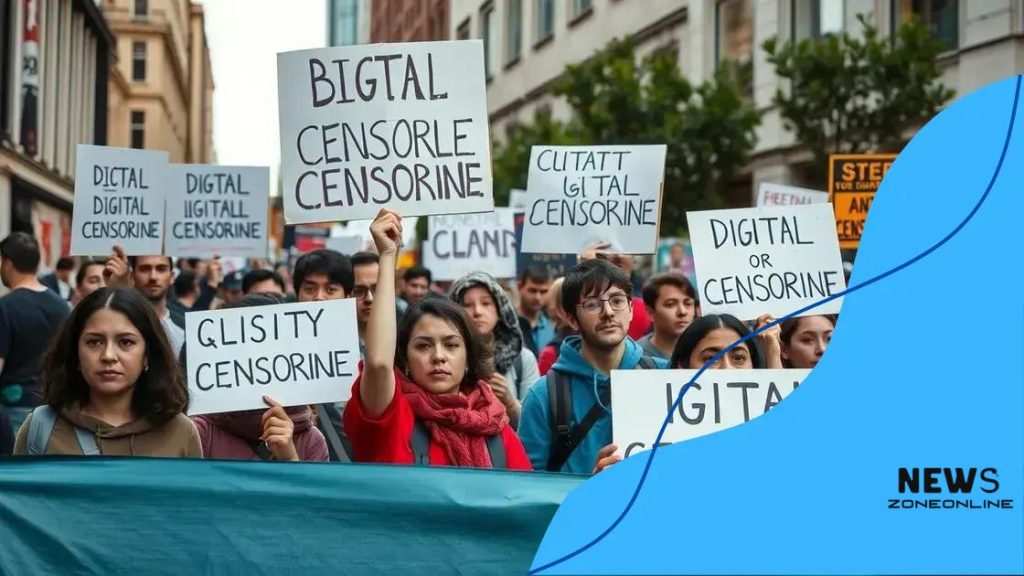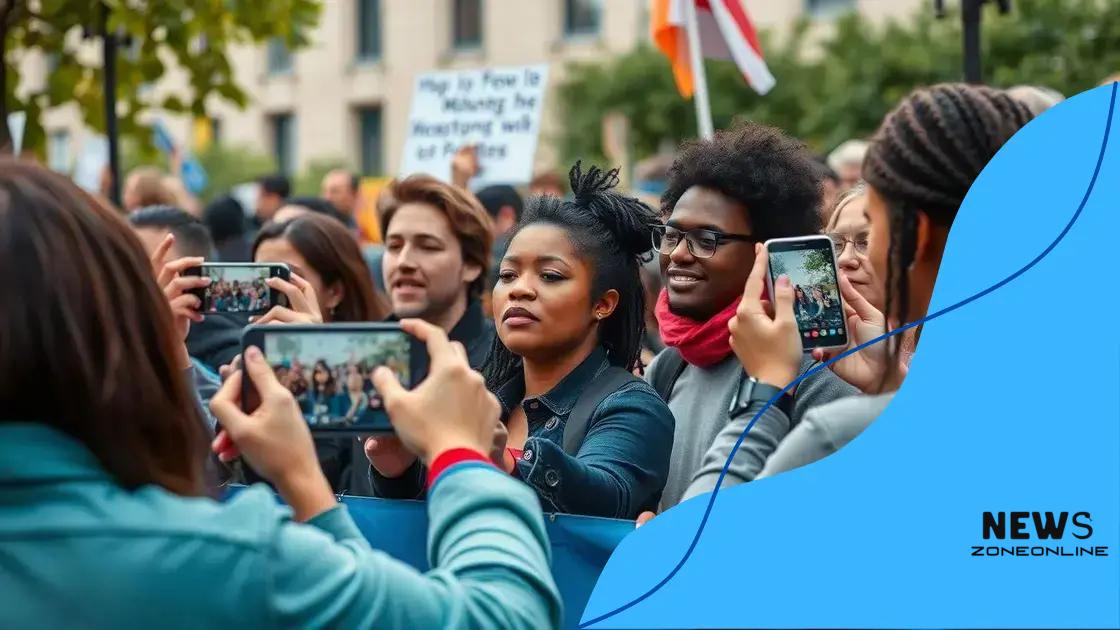Digital censorship protest coverage: what you need to know

Digital censorship limits free speech online through government regulations, platform policies, and societal pressures, raising significant issues about the rights to express and access information in the digital age.
Digital censorship protest coverage is essential in today’s world, where freedom of expression is constantly challenged. Have you wondered how these protests shape public dialogue and policy? In this article, we’ll dive into the nuances of this critical issue.
Understanding digital censorship
Understanding digital censorship is crucial in today’s interconnected world. Digital censorship limits what people can see and say online. It affects how we gather information and communicate.
Many governments impose restrictions that can stifle free speech and harm democracy. It’s essential to grasp the various aspects of this issue.
Types of Digital Censorship
Different methods are employed in managing and restricting online content. Here are a few common types:
- Government Regulation: Laws that dictate what can be shared online.
- Content Filtering: Technologies that block access to specific websites or materials.
- Social Media Policies: Guidelines that platforms set to control what users can post.
- Surveillance: Monitoring users’ activities to prevent dissent.
Understanding these types helps clarify how censorship shapes our online experience. It’s also important to know who is behind these actions. Many organizations and individuals play roles in both supporting and challenging censorship.
Consequences of Digital Censorship
The impact of digital censorship extends beyond just limiting access to information. It can have profound effects on society and individuals. Here are some consequences:
- Stifling Freedom: When people are afraid to speak, creativity and innovation suffer.
- Polarization: Censorship can lead to the division of communities.
- Lack of Awareness: Restricted access to information results in uninformed citizens.
Being aware of these consequences enables individuals to advocate for their rights. It’s essential to stay informed and understand how digital censorship affects everyone.
As we navigate these challenges, people continue to find ways to resist censorship. Tools like VPNs and encrypted messaging have become popular. These technologies allow for safer communication, enabling a broader exchange of ideas.
Recent protests against online censorship
Recent protests against online censorship have highlighted the growing concern for free speech around the world. Many individuals and groups are coming together to voice their discontent with government actions that restrict access to information.
These protests often arise in response to new regulations or laws that limit online expression. People gather in public places, raise their voices on social media, and utilize various platforms to share their stories.
Key Events
Some significant events related to these protests include:
- The Arab Spring: Massive protests in the early 2010s showed the power of social media in organizing against censorship.
- Hong Kong Protests: Activists used digital platforms to mobilize support against government surveillance and oppression.
- Recent Legislative Changes: New laws in various countries have sparked outrage and public demonstrations.
As more people understand the risks of censorship, the movement grows. These protests serve as a reminder that digital rights are human rights. Activists emphasize the importance of having a voice and be able to share information freely.
The Role of Social Media
Social media plays a critical role in organizing and promoting these protests. Platforms like Twitter and Facebook allow people to connect instantly. Through hashtags and posts, messages spread rapidly, reaching a vast audience.
Moreover, these platforms allow for the documentation of events. Videos and images circulate online, showcasing the realities of protests. This visibility can gain international support and raise awareness about the importance of digital freedom.
By sharing experiences and strategies, these movements inspire others to take action. Activists around the globe are learning from one another, adapting their tactics to address different forms of censorship.
Impact of social media on protest coverage

The impact of social media on protest coverage has transformed how events are reported and perceived. These platforms have become vital tools for activists, allowing them to share their messages widely.
In recent years, social media has changed the landscape of news reporting. Traditional media outlets often rely on user-generated content to provide real-time updates and a diverse range of perspectives.
Real-Time Information Sharing
Social media enables immediate communication during protests. Participants can post live updates, which contribute to public understanding of events as they unfold. This immediacy helps keep the audience informed.
- Speed: Information spreads quickly, often outpacing traditional news media.
- Variety: Different voices and viewpoints are presented.
- Accessibility: Anyone with internet access can contribute to the conversation.
Even though social media provides these advantages, it also has challenges. Misinformation can spread just as fast as accurate information, which can complicate how people interpret events.
Amplifying Voices
One of the most significant aspects of social media is its ability to amplify marginalized voices. Activists can reach wider audiences without needing the approval of mainstream media. This has empowered many groups to fight against censorship and inequality.
Campaigns and movements gain traction through hashtags and viral posts. These digital strategies mobilize supporters and raise awareness about pressing issues. The impact of such movements can be substantial, as seen in events like the Black Lives Matter movement.
By utilizing social media, protesters can engage directly with the public and encourage participation. The feedback loop created by user interaction fosters a sense of community and solidarity.
Legal perspectives on digital censorship
Legal perspectives on digital censorship are complex and often vary by region. Laws governing online content aim to balance free expression with societal norms and safety concerns. Understanding these laws is essential for grasping how digital censorship operates worldwide.
In many countries, legislation dictates what content can be shared online. These laws can restrict various forms of expression, leading to debates about their implications for free speech.
Key Legal Frameworks
Several legal frameworks influence digital censorship, including:
- First Amendment (USA): Protects freedom of speech but has limits on certain types of content.
- European Union’s GDPR: Governs data privacy but affects how content is regulated and shared.
- Local Laws: Different countries have unique laws regarding hate speech, defamation, and obscenity.
These laws shape how platforms manage user-generated content. For example, social media sites often comply with local laws, which can lead to varied levels of accessibility and expression based on geographic location.
Challenges to Free Speech
Challenges arise when laws impose strict limits on what can be shared online. Critics argue that these regulations can suppress free speech. Legal battles often occur as individuals and organizations fight against perceived injustices.
Moreover, platforms deal with the dilemma of enforcing policies while maintaining users’ rights to express themselves. This tension is evident in cases involving content moderation and user bans.
Understanding these legal aspects is vital for individuals seeking to navigate the digital landscape. Awareness of the laws governing online behavior empowers users to advocate for digital rights and find ways to challenge unjust censorship.
Future trends in digital free speech
Future trends in digital free speech are shaping up rapidly due to advancements in technology and changing societal norms. As the digital landscape evolves, so do the ways in which individuals express themselves online.
New platforms and technologies are emerging that enhance communication. These innovations enable people to share their thoughts and ideas more effectively.
Emerging Technologies
Technologies like artificial intelligence and blockchain are likely to significantly impact free speech. Here are some ways they will influence future communication:
- AI Moderation: Platforms may use AI to moderate content, balancing free expression while preventing harmful speech.
- Decentralization: Technology like blockchain can decentralize platforms, reducing the control of central authorities over user content.
- Enhanced Privacy: Users may gain better tools for privacy, allowing them to speak freely without fear of surveillance.
Each of these technologies comes with its own challenges. For example, while AI can help manage harmful content, it risks censoring legitimate expression. Decentralized platforms may face hurdles in regulation and user safety.
Societal Movements
In addition to technological changes, societal movements will also drive future trends in digital free speech. As more people advocate for their rights, the conversation around free expression grows stronger. This push for rights can lead to:
- Increased Awareness: People are becoming more aware of online censorship and are demanding greater transparency.
- Policy Changes: Governments and organizations may adjust policies in response to public pressure to protect free speech.
- Global Advocacy: International cooperation among activists is likely to rise, creating a united front against censorship.
As we look ahead, the interplay between technology and societal values will continue to define the future of digital free speech. Staying informed and engaged will empower individuals to navigate this evolving landscape effectively.
In conclusion, understanding the landscape of digital censorship is essential for protecting our rights to free speech. As technology evolves, it presents both new opportunities and challenges. It’s vital to stay informed about legal perspectives and future trends that may impact how we express ourselves online. Activism and awareness are crucial in advocating for a more open digital space. By engaging in this conversation and supporting movements for digital free speech, we can contribute to a future where everyone has the right to share their voice safely and freely.
FAQ – Frequently Asked Questions about Digital Censorship and Free Speech
What is digital censorship?
Digital censorship refers to the suppression of online information and expression. It can be carried out by governments, organizations, or platforms to limit access to certain content.
How does social media impact free speech?
Social media amplifies voices and allows for real-time information sharing, but it can also facilitate the spread of misinformation and trigger censorship.
What legal protections exist for free speech online?
Laws protecting free speech vary by region. In some countries, legislation like the First Amendment in the U.S. safeguards individuals’ rights to express themselves.
What can I do to advocate for digital free speech?
You can stay informed, support activism, engage in discussions about censorship, and advocate for policy changes that protect online expression.





